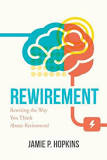Written By: Barbara O’Neill, Ph.D., CFP®, AFC®, CHC
 The best way to describe this book is to restate its central premise: “Rewirement is the process of changing the way you think about retirement to overcome mental and behavioral hurdles holding you back from a more financially secure future.” At 159 pages, it is a quick read and covers a wide range of financial planning topics of interest to younger and older adults. Some of the material is very basic for consumers while other content offers unique insights for practitioners. Below are some key take-aways:
The best way to describe this book is to restate its central premise: “Rewirement is the process of changing the way you think about retirement to overcome mental and behavioral hurdles holding you back from a more financially secure future.” At 159 pages, it is a quick read and covers a wide range of financial planning topics of interest to younger and older adults. Some of the material is very basic for consumers while other content offers unique insights for practitioners. Below are some key take-aways:
Younger Adults
- IRAs have served more as a rollover vehicle than a savings vehicle. Roth IRAs are underutilized in part because tax professionals seek to minimize their clients’ taxes today- not in the future.
- Save for retirement first in an employer plan to take advantage of available matching and then save as much as you can in a Roth IRA.
- If your tax bracket is lower now than 2017 due to the Tax Cuts and Jobs Act, consider a Roth IRA conversion, which is more valuable in a lower tax rate environment.
- Consider taking advantage of a Health Savings Account (HSA) if you have a high deductible health plan (HDHP). HSA savings can be used for future retirement health care costs.
- Invest in your lifetime earning potential. Spend time and money to continue your professional growth even into your mid-sixties.
- People with financial plans accumulate almost 250% more retirement savings than those without a financial plan.
Older Adults
- Knowledge and habits from earlier in life often do not apply any more. For example, the need to spend is more important than the need to save, including the need to take distributions from tax-deferred accounts.
- The housing mantra for older adults is “cash flow, cash flow, cash flow” but it may require downsizing or a reverse mortgage.
- A reverse mortgage can help people defer Social Security to earn a higher benefit. A reverse mortgage would likely charge around 4.5% while Social Security provides guaranteed increases of 7% to 8%.
- Continuing to work 1-2 years longer than planned will improve your retirement security more than saving a few thousand dollars more per year right before retirement.
- Generally, when taking money out of retirement savings, take withdrawals from taxable accounts first, then tax-deferred accounts, and then tax-free or Roth accounts.
- Frailty risk, the gradual loss of physical capability and mental sharpness, needs to be addressed. Options include hiring services, relying on others for assistance, and forgoing tasks. There is an increased risk of elder abuse as more outsiders are introduced into a frail person’s life.
While Rewirement is a valuable resource, I have several suggestions for improvement. The content seemed disjointed at times in both the presentation order of topics and the target audience. For example, while primarily speaking to lay consumers, it seems to address professionals occasionally (e.g., referring to clients on page 68). In addition, it would have been nice to have reference citations for the research studies that were mentioned.
One final thought to summarize a key theme of Rewirement: “If there is one thing to take away from this book, it is the powerful impact of planning. When you are armed with a comprehensive and actionable plan, you can make a huge difference in your retirement happiness and financial success.”